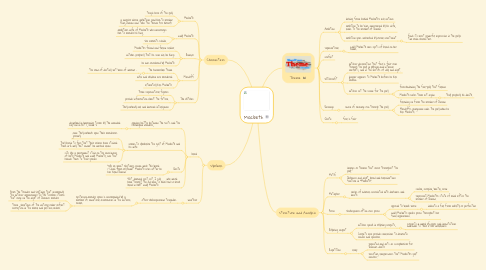
1. Characters
1.1. Macbeth
1.1.1. tragic hero of the play
1.1.2. a warrior whose ambitions lead him to murder King Duncan and take the throne for himself
1.2. Lady Macbeth
1.2.1. ambitious wife of Macbeth who encourages him to murder his king.
1.2.2. She commits suicide.
1.3. Banquo
1.3.1. Macbeth's friend and fellow soldier.
1.3.2. witches prophesy that his sons will be kings
1.3.3. he was murdered by Macbeth
1.4. Macduff
1.4.1. the honourable thane
1.4.1.1. the man of destiny 'not born of woman' –
1.4.2. wife and children are murdered
1.4.3. ultimately kills Macbeth.
1.5. The Witches
1.5.1. three supernatural figures
1.5.2. provide information about the future.
1.5.3. They embody evil and demonic intelligence
2. Symbols
2.1. blood
2.1.1. opening battle between the Scots and the Norwegian invaders,
2.1.1.1. described in harrowing terms by the wounded captain in Act 1, scene 2
2.1.2. comes to symbolize the guilt of Macbeth and his wife
2.1.2.1. once they embark upon their murderous journey
2.1.2.2. they begin to feel that their crimes have stained them in a way that cannot be washed clean
2.1.2.3. sits like a permanent stain on the consciences of both Macbeth and Lady Macbeth, one that hounds them to their graves
2.1.3. Quote
2.1.3.1. “Will all great Neptune’s ocean wash this blood / Clean from my hand?” Macbeth cries after he has killed Duncan
2.1.4. “Out, damned spot; out, I say . . . who would have thought the old man to have had so much blood in him?” Lady Macbeth
2.2. weather
2.2.1. other Shakespearean tragedies
2.2.1.1. grotesque murder spree is accompanied by a number of unnatural occurrences in the natural realm.
2.2.1.1.1. From the thunder and lightning that accompany the witches’ appearances to the terrible storms that rage on the night of Duncan’s murder
2.2.1.1.2. these violations of the natural order reflect corruption in the moral and political orders.
3. Theme
3.1. Ambition
3.1.1. driving force behind Macbeth's evil actions
3.1.2. ambition to be king, encouraged by his wife, leads to the murder of Duncan.
3.1.3. ambition goes unchecked by moral constraint
3.1.3.1. finds its most powerful expression in the play’s two main characters
3.2. Supernatural
3.2.1. Lady Macbeth sees spots of blood on her hands.
3.3. conflict
3.4. Witchcraft
3.4.1. witches' declaration that 'foul is fair' runs through the play in physical and internal conflicts, and in the motifs of day and night.
3.4.2. dagger appears to Macbeth before he kills Duncan
3.4.3. witches set the scene for the play
3.4.3.1. foreshadowing the foul-play that follows
3.4.3.2. Macbeth seeks them out again
3.4.3.2.1. they prophesy his death.
3.5. Revenge
3.5.1. sense of revenge run through the play
3.5.1.1. following on from the murder of Duncan
3.5.1.2. Macduff's vengeance ends the play when he kills Macbeth.
3.6. Quote
3.6.1. 'foul is fair'
4. Structure and Analysis
4.1. Motif
4.1.1. images or themes that recur throughout the play.
4.1.2. Darkness and night, blood and hallucinations feature in "Macbeth".
4.2. Metaphor
4.2.1. series of animals associated with darkness and death
4.2.1.1. snake, scorpion, beetle, crow
4.2.1.2. represent Macbeth's state of mind after the murder of Duncan.
4.3. Prose
4.3.1. Shakespeare often uses prose
4.3.1.1. opposed to blank verse
4.3.1.1.1. indicate a fall from nobility or perfection
4.3.1.2. Lady Macbeth speaks prose throughout her final appearance.
4.4. Rhyming couplet
4.4.1. witches speak in rhyming couplets,
4.4.1.1. suggests a world of spells and incantations and adds to their other worldliness
4.4.2. Couplets also provide conclusions to dramatic scenes and speeches.
4.5. Repetition
4.5.1. sleep
4.5.1.1. repeated and acts as a euphemism for Duncan's death
4.5.1.2. resulting sleeplessness that Macbeth's guilt ensures.
